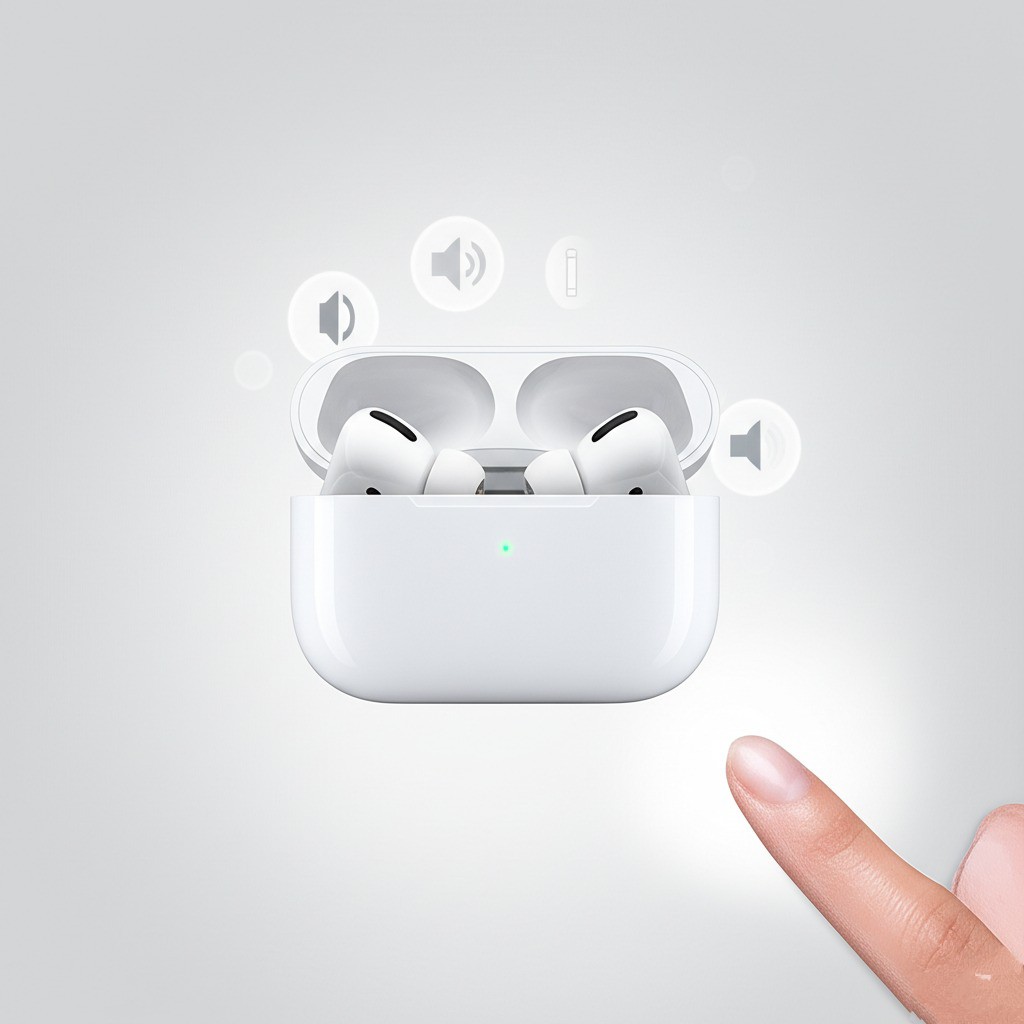Ever had your AirPods act a little… finicky? Maybe one AirPod isn’t playing sound, or they just won’t connect to your device, no matter what you try. It’s super frustrating, right? But here’s the thing: often, the solution is much simpler than you think. A good old reset can often work wonders, bringing your beloved earbuds back to life.
Think of it like restarting your computer when it acts up. Sometimes, a fresh start is all it takes to clear out those digital cobwebs and get things running smoothly again.
And the good news is, resetting your AirPods is a straightforward process, whether you have the original AirPods, AirPods Pro, or even the mighty AirPods Max.
In this guide, we’re going to walk you through everything you need to know about resetting your AirPods. We’ll cover why you might need to do it, the different types of resets, and step-by-step instructions for each AirPod model. So, let’s get those tunes flowing flawlessly again!
Table of Contents
Key Takeaways
- Why Reset? Resetting AirPods can fix common issues like connection problems, sound drops, charging glitches, or prepare them for a new owner.
- Two Main Types: There’s a “soft reset” (reconnecting) for minor glitches and a “factory reset” for more stubborn problems or when selling them.
- Easy Steps: Both types of resets are simple, usually involving the charging case button and your device’s Bluetooth settings.
- Troubleshooting Tool: A reset is a key troubleshooting step before considering repairs or replacements.
- Model Variations: While the steps are similar, there are slight differences, especially for AirPods Max, so follow the specific instructions for your model.
Understanding the “Why”: When Do You Need to Reset Your AirPods?
So, why would you even need to reset your AirPods in the first place? Well, just like any piece of tech, they can sometimes run into glitches. Here are some of the most common reasons you might find yourself needing to hit that reset button:
- Connection Problems: Your AirPods won’t connect to your iPhone, iPad, or Mac? Or maybe they keep disconnecting randomly? This is probably the most common reason people look up how to reset them.
- Sound Issues: One AirPod isn’t playing sound, or the volume seems off, or maybe the audio keeps cutting out. Annoying, right?
- Charging Glitches: Your AirPods aren’t charging properly, or the case isn’t showing the right battery level.
- Pairing with a New Device: You want to connect your AirPods to a brand new phone or computer, and they’re being stubborn.
- Selling or Gifting: If you’re passing your AirPods on to someone else, a factory reset ensures all your personal data is wiped clean. It’s like giving them a fresh start!
- Firmware Updates: Sometimes, after a firmware update, a reset can help stabilize performance.
Pull Quote: “A reset is often the simplest fix for the most frustrating AirPod issues. Don’t underestimate its power!”
It’s important to know that there are generally two types of “resets” people talk about:
- Soft Reset (Reconnecting): This is less of a full reset and more like a fresh reconnection. It’s often the first thing to try for minor hiccups.
- Factory Reset (Hard Reset): This is the big one. It wipes all settings, forgets your device, and puts your AirPods back to their original factory state. This is what you do for persistent problems or when preparing them for a new owner.
Let’s dive into how to perform both.
Before You Reset: A Quick Checklist
Before you jump straight to resetting, it’s worth trying these quick fixes. Sometimes the problem isn’t as big as it seems!
- Charge Them Up: Make sure both your AirPods and their charging case are fully charged. Low battery can cause all sorts of weird issues.
- Clean Them: Dust, lint, or earwax can sometimes block sensors or charging contacts. Give your AirPods a gentle clean with a soft, dry cloth or a cotton swab.
- Restart Your Device: Sometimes the problem isn’t the AirPods, but the device they’re connected to. Try turning your iPhone, iPad, or Mac off and then back on.
- Update Software: Ensure your iPhone, iPad, or Mac is running the latest version of iOS/iPadOS/macOS. Also, AirPods often get firmware updates automatically, but ensuring your device is up-to-date helps.
Anyway, if those quick checks didn’t work, it’s time for a proper reset!
How to Perform a Soft Reset (Reconnecting)
This is the easiest fix and often solves minor connection glitches. It’s not a true “reset” in the sense of wiping data, but it forces your AirPods to re-establish their connection.
Steps for AirPods (all generations), AirPods Pro (all generations), and AirPods Max:
- Put AirPods in Case: Place both AirPods back into their charging case. If you have AirPods Max, simply place them in their Smart Case.
- Close the Lid: Close the lid of the charging case. For AirPods Max, ensure they are snugly in their Smart Case.
- Wait a Few Seconds: Give it about 15-30 seconds. This allows them to “reset” their internal connection.
- Open the Lid (or take out AirPods Max): Open the case lid (with AirPods still inside) or take your AirPods Max out of their Smart Case.
- Check Connection: Try connecting them to your device again.
If this doesn’t work, it’s time for the more powerful factory reset.
How to Perform a Factory Reset (Hard Reset)
This process completely resets your AirPods to their original factory settings, just like they were when you first took them out of the box. This is the go-to solution for persistent problems.
Method 1: For AirPods (all generations) & AirPods Pro (all generations)
This is the most common method and works for pretty much all in-ear AirPods.
What you’ll need: Your AirPods, their charging case, and your iPhone/iPad/Mac.
Step-by-step Guide:
- Forget AirPods on Your Device:
- On your iPhone or iPad, go to Settings > Bluetooth.
- Find your AirPods in the list (e.g., “John’s AirPods Pro”).
- Tap the “i” icon next to their name.
- Tap “Forget This Device” and confirm. This is a crucial step! If you’re on a Mac, go to System Settings > Bluetooth, find your AirPods, click the “X” next to them, and then “Remove”.
Why do this first? Because your device “remembers” your AirPods. Forgetting them ensures a truly fresh start.
- Place AirPods in Case & Close Lid: Put both AirPods back into their charging case and close the lid.
- Open Lid & Locate Button: Open the lid of the charging case. You’ll see a small, circular setup button on the back of the case.
- Press and Hold the Setup Button:
- Press and hold down this setup button for about 15 seconds.
- Watch the status light on the front of the case (or inside the case for some models). It will flash white, then amber (orange), and finally white again.
- CRITICAL: Do not release the button until the light flashes amber and then white again. This signifies a successful reset.
- Reconnect AirPods:
- Once the light is flashing white, your AirPods are reset and ready to pair.
- Hold the open charging case (with AirPods inside) close to your iPhone or iPad.
- A setup animation will appear on your screen. Follow the on-screen instructions to reconnect your AirPods. It’s usually just a tap of the “Connect” button.
And just like that, you’re done! Your AirPods should now be behaving like new.
Method 2: For AirPods Max
AirPods Max have a slightly different process because they don’t have a traditional “case button” in the same way.
What you’ll need: Your AirPods Max and your iPhone/iPad/Mac.
Step-by-step Guide:
- Forget AirPods Max on Your Device:
- Just like with the other AirPods, go to Settings > Bluetooth on your iPhone/iPad or System Settings > Bluetooth on your Mac.
- Find your AirPods Max, tap the “i” icon (or “X” on Mac), and select “Forget This Device” to remove them from your list.
- Charge if Needed: Ensure your AirPods Max have some charge. If the battery is very low, they might not respond correctly.
- Locate Noise Control & Digital Crown: Find the Noise Control button (the smaller, oval one) and the Digital Crown (the larger, round one) on the right ear cup.
- Press and Hold Both Buttons:
- Simultaneously press and hold down both the Noise Control button and the Digital Crown for about 15 seconds.
- Watch the status light on the bottom of the right ear cup. It will flash amber (orange), then white.
- Release the buttons once the light turns white.
- Reconnect AirPods Max:
- Once the light is white, your AirPods Max are reset and ready to pair.
- Hold them close to your iPhone or iPad.
- A setup animation will appear on your screen. Follow the on-screen instructions to reconnect.
Common Issues a Reset Can Fix (and What It Can’t)
A reset is a powerful tool, but it’s not a magic wand for every problem. Here’s a quick rundown:
Check off the issues you're experiencing with your AirPods to get a recommendation!
🔗 Connection Issues
🔊 Sound Problems
🔋 Charging & Battery
⚙️ Other Issues
When NOT to Reset Your AirPods (and What Else to Try)
While a reset is super helpful, it’s not always the answer. Sometimes, the problem lies elsewhere.
- Physical Damage: If your AirPods have been dropped in water, run over by a car (yikes! 🚗), or have obvious cracks, a reset won’t fix hardware damage. In these cases, you’re likely looking at a repair or replacement.
- Battery Degradation: All batteries wear out over time. If your AirPods are old and barely hold a charge, a reset won’t magically give them new battery life.
- Device Compatibility: Are you trying to connect your AirPods to a really old device that doesn’t support the necessary Bluetooth version? A reset won’t fix compatibility issues.
So, what if a reset doesn’t work?
- Check Apple Support: Head over to the official Apple Support website for specific troubleshooting guides. They have tons of resources!
- Contact Apple Support: If you’ve tried everything and your AirPods are still acting up, it might be time to chat with an expert. They can diagnose deeper issues.
- Consider Alternatives: If your current AirPods are beyond repair, or if you’re looking for a different audio experience, maybe it’s time to explore other options. For instance, if you’re a serious gamer, you might want to look into the best gaming CPUs for your PC setup, which can impact audio processing. Or, for dedicated workouts, check out the best over-ear headphones for working out if in-ear buds aren’t cutting it.
- Wired vs. Wireless: Sometimes, the convenience of wireless connectivity comes with its own set of challenges. If you’re constantly battling connection issues, you might want to read up on the wireless vs. wired debate to see if a wired solution might be better for your specific needs, especially for critical audio tasks like podcasting, where a reliable connection is key – perhaps even exploring cheap podcast microphones if you’re setting up a home studio.
- Laptop Issues: Believe it or not, sometimes a laptop’s performance can affect Bluetooth connections. If your laptop is overheating, it might be throttling its performance, including wireless capabilities. In that case, a best laptop cooling pad might indirectly help improve your overall system stability, which in turn could lead to more reliable AirPod connections.
Tips for Keeping Your AirPods Happy
Prevention is always better than cure, right? Here are some simple tips to keep your AirPods running smoothly and hopefully avoid needing frequent resets:
- Keep Them Clean: Regularly wipe down your AirPods with a soft, dry, lint-free cloth. Pay attention to the speaker grilles and charging contacts.
- Store Them Properly: Always keep your AirPods in their charging case when not in use. This protects them from dust, debris, and physical damage.
- Avoid Extreme Temperatures: Don’t leave your AirPods in a hot car or out in freezing cold weather. Extreme temperatures can damage the battery and internal components.
- Charge Regularly: Don’t let your AirPods’ battery completely drain too often. Regular, moderate charging is better for battery longevity.
- Update Your Devices: Keep your iPhone, iPad, Mac, and other connected devices updated to the latest software versions. This ensures your AirPods have the latest firmware and bug fixes.
- Handle with Care: They’re small and can be easily dropped. Be mindful when taking them out or putting them away.
Final Thoughts
Honestly, it’s pretty satisfying when you can troubleshoot a tech problem yourself, isn’t it? Resetting your AirPods is a simple yet powerful way to fix a wide range of common issues, from frustrating connection drops to mysterious audio glitches. It’s often the first, best step to take before you panic or consider buying a new pair.
By following the steps outlined in this guide, you should be able to get your AirPods back to their optimal performance, enjoying clear, uninterrupted sound once again. So, next time your AirPods decide to have an off day, you’ll know exactly how to give them that much-needed fresh start. Happy listening!



